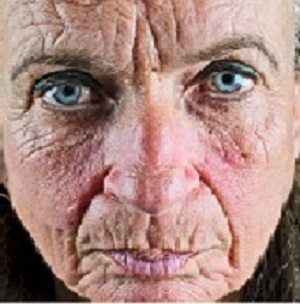 Heavy drinking and smoking are linked to four visible signs of physical ageing, and looking older than one's years, found a long-term Danish observational study.
Heavy drinking and smoking are linked to four visible signs of physical ageing, and looking older than one's years, found a long-term Danish observational study.
The research was from the National Institute of Public Health, University of Southern Denmark and Frederiksberg Hospital, Copenhagen, Denmark. Light to moderate drinking was not associated with biological ageing, the findings showed. But nor was it linked to the slowing of the visible ageing process as there was no difference in the prevalence of the signs of ageing between light to moderate drinkers and non-drinkers, the researchers point out.
They base their findings on information from more than 11,500 adults, whose heart health and visible aging signs were tracked for an average of 11.5 years as part of the Copenhagen City Heart Study. This study, which began in 1976, has been monitoring a random sample of Danish people over the age of 20 living in the Copenhagen area in 1981-3, 1991-4, and in 2001-3.
Before each of the clinic visits, participants were quizzed about their lifestyle and general health and asked to state how much they drank and smoked. And they were checked for four signs of ageing that have previously been linked to a heightened risk of cardiovascular ill health and/or death.
These were: earlobe creases; a greyish opaque coloured ring or arc around the peripheral cornea of both eyes (arcus corneae); yellow-orange plaques on the eyelids (xanthelasmata); and male pattern baldness (receding hairline or a bald patch on the top of the head).
The average age of the participants was 51, but ranged from 21 to 86 among the women, and from 21 to 93 among the men. Average alcohol consumption was 2.6 drinks/week for women and 11.4 for men. Just over half the women (57%) and around two thirds of the men (67%) were current smokers.
Arcus coneae was the most common sign of aging among both sexes, with a prevalence of 60% among men over 70 and among women over 80. The least common sign was xanthelasmata, with a prevalence of 5% among men and women over 50. A receding hairline was common among men, with 80% of those over the age of 40 affected.
Analysis of drinking and smoking patterns revealed a consistently heightened risk of looking older than one's true age and developing arcus corneae, earlobe creases, and xanthelasmata among those who smoked and drank heavily.
For example, compared with a weekly alcohol intake of up to 7 drinks, a tally of 28 or more was associated with a 33% heightened risk of arcus coneae among the women, and a 35% heightened risk among men who knocked back 35 or more drinks every week. Similarly, compared with not smoking, smoking one pack of 20 cigarettes daily for between 15 and 30 years was associated with a 41% heightened risk among women and a 12% heightened risk among men.
The occurrence of the visible signs of ageing was no different among light to moderate drinkers than it was among non-drinkers, the analysis showed. Male pattern baldness was not consistently associated with heavy drinking or smoking, possibly because it is strongly influenced by genes and circulating levels of male hormones (androgens), suggest the researchers.
This is an observational study so no firm conclusions can be drawn about cause and effect, particularly as the data on smoking and drinking relied on personal recall, which is subject to bias. And while the researchers took account of a range of potentially influential factors, they were unable to take account of stress, which is associated both with cardiovascular disease risk and smoking and heavier drinking.
Nevertheless, they conclude: "This is the first prospective study to show that alcohol and smoking are associated with the development of visible age-related signs and thus generally looking older than one's actual age… This may reflect that heavy drinking and smoking increases general ageing of the body."
Abstract
Background: Visible age-related signs indicate biological age, as individuals that appear old for their age are more likely to be at poor health, compared with people that appear their actual age. The aim of this study was to investigate whether alcohol and smoking are associated with four visible age-related signs (arcus corneae, xanthelasmata, earlobe crease and male pattern baldness).
Methods: We used information from 11 613 individuals in the Copenhagen City Heart Study (1976–2003). Alcohol intake, smoking habits and other lifestyle factors were assessed prospectively and visible age-related signs were inspected during subsequent examinations.
Results: The risk of developing arcus corneae, earlobe crease and xanthelasmata increased stepwise with increased smoking as measured by pack-years. For alcohol consumption, a high intake was associated with the risk of developing arcus corneae and earlobe crease, but not xanthelasmata.
Conclusions: High alcohol consumption and smoking predict development of visible age-related signs. This is the first prospective study to show that heavy alcohol use and smoking are associated with generally looking older than one’s actual age.
Authors
Anne L Schou, Marie-Louise Mølbak, Peter Schnor, Morten Grønbæk, Janne S Tolstrup
[link url="http://www.bmj.com/company/newsroom/heavy-drinking-and-smoking-linked-to-visible-signs-of-ageing/"]BMJ material[/link]
[link url="http://jech.bmj.com/content/71/12/1177"]Journal of Epidemiology & Community Health abstract[/link]
